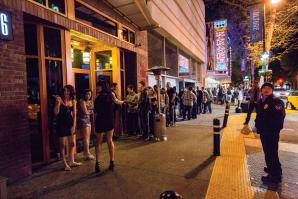Sacramento Police Chief Sam Somers, Jr.

Sacramento Police Chief Sam Somers Jr. is still fairly new to his position, but he is hardly fresh to Sacramento or law enforcement. Born and raised here, the Encina High School and Sacramento State graduate is a second-generation cop with 29 years on the force. In that time, Somers has held numerous command positions within the department, from street patrols to the SWAT team. We sat down with him recently to discuss the job and the intersection of the police force and the business community.
Comstock’s: You are from a police family.
How long was your dad with Sacramento PD?
Somers: 30 years.
Comstock’s: So going into public safety
wasn’t really a question, right?
Somers: Sometimes people are born into it. It
kind of looks like I was, but I didn’t know this was what I
wanted to be when I was younger. It’s funny how it came back to
this, and once I kind of did it, it was fun.
Comstock’s: Your predecessor, Chief Rick
Braziel, has said policing is very similar to business, with
customers and clientele. Do you agree with that?
Somers: Well, we do have customers — the people
who call us and need a service every day. The one difference
between us and a real business is that we don’t turn a profit. We
can’t look at the ledger and say, ‘We made money today.’ What we
can measure is, ‘Did we reduce crime, or was somebody satisfied
with the service we supplied to them?’ But like with other
businesses, our customers also have options. You can hire private
security to help police your neighborhood. Some people supplement
their communities because they want additional service, or it
might be a failure on our part. It might be that we’re not
supplying enough service. That’s something we look at very
closely to see, maybe, where we’ve dropped [and why] they felt
they needed to supplement what we were providing.
Comstock’s: How do you see the relationship
between the Sacramento Police Department and the business
community?
Somers: I think it’s very good and robust. We’ve
spent a lot of years really trying to grow that relationship, and
we have a lot of attachments with the business corridors. We
attend their regular meetings, and we’re consulted on a lot of
issues business owners have. We also have direct liaisons with
them so that when they have a particular issue, they can cut
through the bureaucracy and get the answer they need. We always
try to be proactive. For instance, we have programs where
business owners can learn from us how to better secure their
business. We use a lot of concepts called ‘crime prevention
through environmental design,’ which can be as simple as fencing.
We share info on creating barriers and defensible space,
installing proper lighting, making sure you set your business up
so that you’re not going to be an easy target. Best of all, we
come in and do the evaluation, and it doesn’t cost you anything.
Comstock’s: What more can businesses do to
help you help them?
Somers: Something that really helps us is for
them to come together with a singular message of things that we
need to work on for the broader area as opposed to each one of
their individual issues. Look at the Midtown Association or the
Downtown Partnership. As opposed to having 25 businesses telling
us their individual needs, they get together, they have an
executive director and they can prioritize their needs. That’s
huge for us.
Comstock’s: Downtown has had some
high-profile problems in recent years. Let’s face it, bars and
nightclubs present a different kind of problem for you than a
hardware store. How important is it for those specific businesses
to figure out ways to help you?
Somers: First, I would challenge you to find any
other community with a similarly vibrant nightlife that doesn’t
have some of these issues. That said, it’s very important. Many
in that area have come together and hired some of our extra
officers to do specific patrol in certain areas at particular
times. But they also do other things. They have radios at all the
different bars, so if you get one knucklehead in a particular
bar, he can’t just walk two businesses down and become a
knucklehead there, too. They can alert one another and our
officers, so if they have a problem we can maybe go look for that
person ahead of time, and we can get that person out of there.
Overall, I think the downtown bars have been very proactive in
dealing with these things when they come up.
Comstock’s: You’ve said you want to increase
diversity in Sac PD. What is the plan for doing that?
Somers: We have a variety of plans, but the very
first thing you have to do is to be able to hire. That means we
need to have the money to actually hire new officers. No. 2, we
need a very diverse candidate pool because it takes about 100
applicants to get even three people in the pipeline that we can
hire. To get that, we already do a lot of the traditional stuff —
job fairs and outreach in colleges — which is important because
we require 60 college units to be an officer in the Sacramento
Police Department. We target as diverse a group as we can, and in
some areas we do OK and in some areas we don’t do so well. So
going forward, we’re trying to break down some barriers. I have a
program called Cops and Clergy we’re using as an intervention
program, but which is also getting us into some of the diverse
neighborhoods where the perception of us isn’t as good as it
should be or can be. We’re partnering with the churches and
developing relationships that are about action, not just words.
Clergy has a different perception of cops, of what we’re really
trying to do, and they can take us inside and introduce us as
their friend, someone their community can trust. Because at the
end of the day, if you don’t trust me, why would you want to work
for me?
Comstock’s: I understand Measure U is going
to give you some money and that you’re hoping to bring in 50
officers. Is that correct?
Somers: Once I get the hard-line numbers and
know exactly what monies are coming our way, it will give me a
good idea of exactly how many we’re going to be able to hire.
We’re having an academy in July that we’re trying to get 40
officers into. As I said, you have to put a lot of people
through, and the process here is not real simple. It’s a written
test, an oral test, a physical test, a background process,
medical test, psychological test. On top of that, you have six
months with the academy and then six months on the street in
field training. So, it’s about an 18-month process to get a body
here. So, if I graduate 40 officers out of the academy, I’ll be
very happy. We have an attrition rate out of that, so you’re
probably looking at somewhere in the 30s. If I can also attract
quality officers from other agencies, then I can fill in the
blanks from there.
Comstock’s: Will you be able to return to
your “POP” plan, the problem-oriented policing program that has
shown to be effective in the past?
Somers: When I ran the south command,
community members would tell me, ‘I know my POP officer by name
and my POP officer knows me by name and we have a great working
relationship and they really help me out, but these patrol
officers come in and handle a call and leave. I’d really like to
get to know them.’ So I need more officers on patrol, but not
just to do normal patrol work, but to do more of this
proactive work. I started a thing this year called geographical
policing, which entails us having 18 beats in the city, with six
districts under three commands. Each lieutenant owns two beats,
so two parts of the city where they’re going to have
accountability on a 24/7 basis. I need to give them more
resources so they can start giving those officers more time to
have that interaction with the community. Because, at the end of
the day, who knows those communities better than those officers?
Comstock’s: How much of an issue is prison
realignment for your force?
Somers: The jury is still out. I don’t think
we’ll know for a couple of years. When you send someone to
prison, it’s like sending them to crime school. Maybe someone was
pretty bad going in, but when they come out they’re worse. So
it’s concerning to me because now we have to deal with it. But
that doesn’t mean that it’s insurmountable. The question is: Will
we come up with a new system that actually has a better way of
providing justice? Will that be a long-term solution as opposed
to another short-term incarceration solution that just tries to
warehouse everybody? Because now we think that if we just lock
them up then the problem goes away, but the truth is it only goes
away for a little bit.
Recommended For You

All Eyes on Kay
Beefed-up security steadies K Street
Sac Town revelers along K Street seem oblivious to new coordinated efforts by the Sacramento police, city officials, pubs, clubs and bars to deploy new layers of security and preparedness which, well, probably account for the harmony on this Friday evening in March.

Are You Watching?
Smart companies take advantage of new security options
The scene was right out of a TV cop drama. Shots rang out. A crowd ducked for cover. The bad guys sped off in a getaway car. The incident in a Sacramento shopping mall last year was real life. But just like on television, the case was wrapped up in three hours, with the bad guys in jail and the car impounded.


